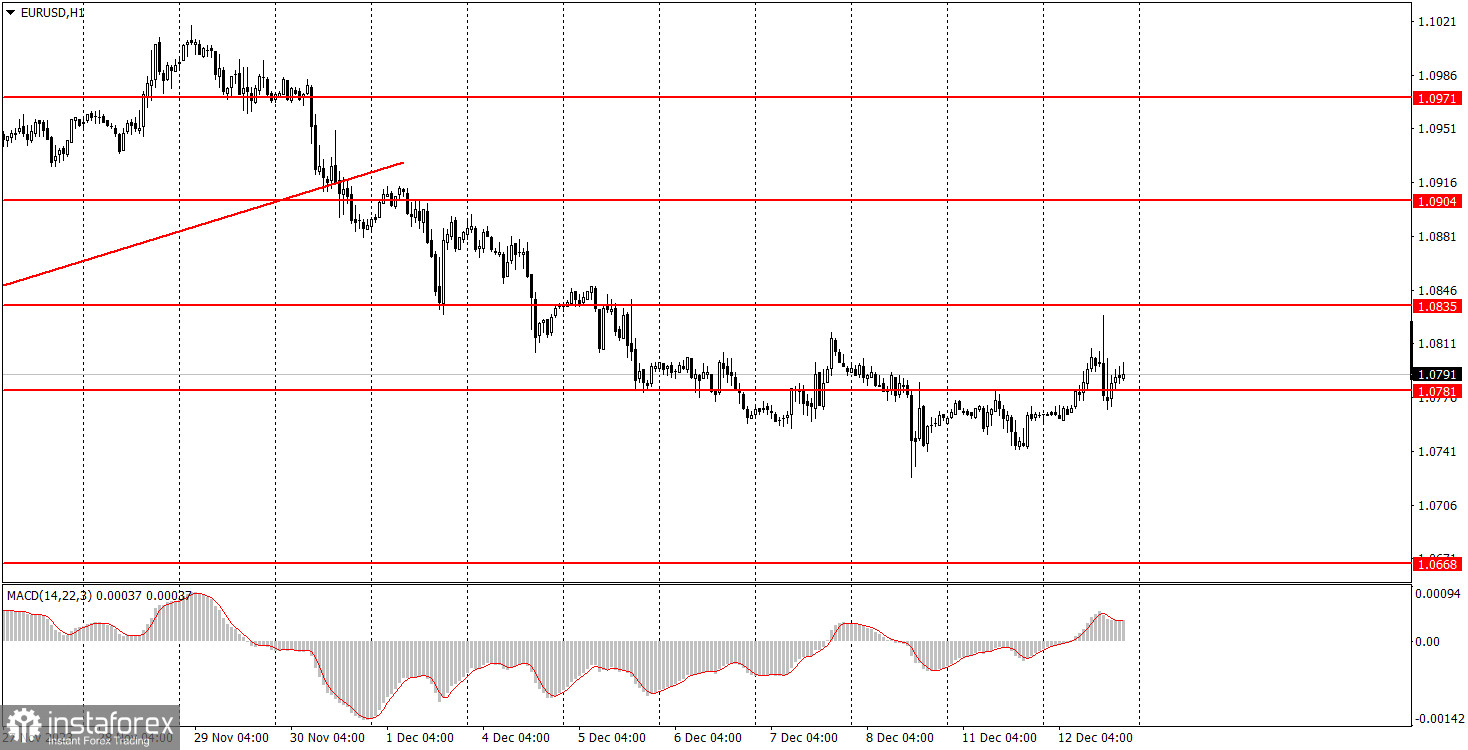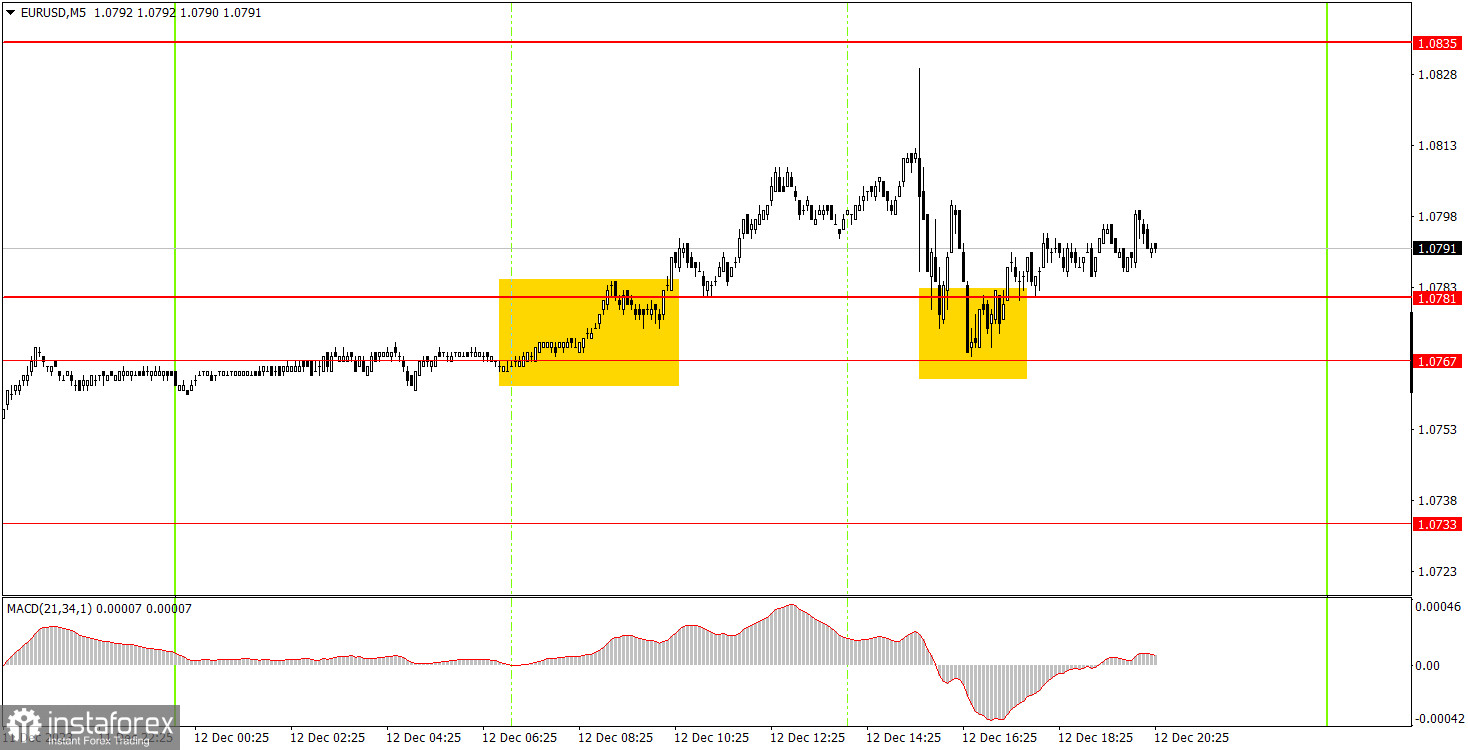Analyzing Tuesday's trades:
EUR/USD on 30M chart

On Tuesday, EUR/USD finally started to correct higher. The euro started to rise before the US inflation data. In the morning, two ZEW reports painted a slightly better picture for the German and euro area economy, and the single currency edged up. In the afternoon, the US inflation report was released, which showed exactly the slowdown expected—0.1%. It is difficult to answer why the US dollar moved higher after such a result. The formal decrease in inflation means that the chances of the Federal Reserve tightening its monetary policy become even smaller. Therefore, it would have been more logical for the pair to rise. At the same time, the US CPI data met expectations, so there could have been no reaction at all. We believe that the market worked through this report by momentum, and the direction of the pair's movement was insignificant.
EUR/USD on 5M chart

Two good trading signals were generated on the 5-minute chart. At the beginning of the European session, the price overcame the 1.0767-1.0781 range, afterwards the price was up by about 40 pips. Unfortunately, it did not reach the nearest target level, but beginners could manually close long positions before the release of US inflation data since they were profitable at that time, and the inflation report could easily provoke a decline. Later, the second buy signal — a bounce from the 1.0767-1.0781 range. This signal could also be executed, but the upward movement was very weak. Nevertheless, it was possible to earn a good amount of profit.
Trading tips on Wednesday:
On the hourly chart, EUR/USD continues to form a new downtrend. Despite the good chances of an upward correction, we believe that the downtrend is not over. This week, the pair may rise since there will be many significant fundamental events. However, overall, we believe that the pair should fall as the euro has no good reason to justify a stronger upward movement than a correction.
We suggest that you closely monitor the 1.0767-1.0781 range. Movement may be strong, but our advice would be more applicable in the evening.
The key levels on the 5M chart are 1.0568, 1.0611-1.0618, 1.0668, 1.0733, 1.0767-1.0781, 1.0835, 1.0896-1.0904, 1.0940, 1.0971-1.0981, 1.1011, 1.1043, 1.1091. On Wednesday, the key event of the day will be the FOMC meeting. There will also be a press conference with Fed Chair Jerome Powell. From the European Union, the industrial production report will be published.
Basic trading rules:
1) Signal strength is determined by the time taken for its formation (either a bounce or level breach). A shorter formation time indicates a stronger signal.
2) If two or more trades around a certain level are initiated based on false signals, subsequent signals from that level should be disregarded.
3) In a flat market, any currency pair can produce multiple false signals or none at all. In any case, the flat trend is not the best condition for trading.
4) Trading activities are confined between the onset of the European session and mid-way through the U.S. session, post which all open trades should be manually closed.
5) On the 30-minute timeframe, trades based on MACD signals are only advisable amidst substantial volatility and an established trend, confirmed either by a trend line or trend channel.
6) If two levels lie closely together (ranging from 5 to 15 pips apart), they should be considered as a support or resistance zone.
How to read charts:
Support and Resistance price levels can serve as targets when buying or selling. You can place Take Profit levels near them.
Red lines represent channels or trend lines, depicting the current market trend and indicating the preferable trading direction.
The MACD(14,22,3) indicator, encompassing both the histogram and signal line, acts as an auxiliary tool and can also be used as a signal source.
Significant speeches and reports (always noted in the news calendar) can profoundly influence the price dynamics. Hence, trading during their release calls for heightened caution. It may be reasonable to exit the market to prevent abrupt price reversals against the prevailing trend.
Beginning traders should always remember that not every trade will yield profit. Establishing a clear strategy coupled with sound money management is the cornerstone of sustained trading success.





















